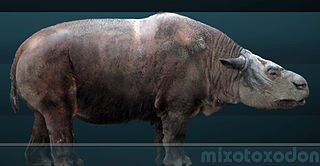 W
WArctotherium is an extinct genus of Pleistocene South American short-faced bears within Ursidae. Their ancestors migrated from North America to South America during the Great American Interchange, following the formation of the Isthmus of Panama during the late Pliocene. The oldest dated confirmed remains are those of A. angustidens from Buenos Aires, Argentina, dating to the Ensenadan epoch, 1.76 to 0.98 Ma old, within the Early to Middle Pleistocene, with a tooth possibly belonging to Arctotherium dating about 2.588 Mya. They are genetically closer to the spectacled bear, than to Arctodus of North America, implying the two extinct forms evolved large size in a convergent manner, perhaps to facilitate dominating other carnivores in the competition for the biggest carcasses. The northernmost species, A. wingei, known from Venezuela in South America, apparently invaded Central America and reached as far north as the Yucatán.
 W
WBorophagus hilli is an extinct species of the genus Borophagus of the subfamily Borophaginae, a group of canids endemic to North America from the Late Miocene until the Pliocene.
 W
WCuvieronius is an extinct New World genus of gomphotheres and is named after the French naturalist Georges Cuvier. Alive, specimens typically stood about 2.3 m (7.5 ft) tall at the shoulder, weighed about 3.5 t and would have superficially resembled a modern elephant with spiral-shaped tusks.
 W
WGlyptotherium is an extinct genus of glyptodont, a group of extinct mammals related to the armadillos living from the Middle to Late Pleistocene, approximately 1.8 million to 12,000 years ago (AEO). The genus is considered an example of North American megafauna, of which most have become extinct. Glyptotherium may have been wiped out by changing climate or human interference.
 W
WHemiauchenia, synonym Tanupolama, is a genus of lamine camelids that evolved in North America in the Miocene period about 10 million years ago. This genus diversified and moved to South America in the Early Pleistocene, as part of the Great American Biotic Interchange, giving rise to modern lamines. The genus became extinct at the end of the Pleistocene.
 W
WHolmesina is a genus of pampathere, an extinct group of armadillo-like creatures that were distantly related to extant armadillos. Like armadillos, and unlike the other extinct branch of megafaunal cingulates, the glyptodonts, the shell was made up of flexible plates which allowed the animal to move more easily. Holmesina species were herbivores that grazed on coarse vegetation; armadillos are mostly insectivorous or omnivorous.
 W
WMixotoxodon is an extinct genus of notoungulate of the family Toxodontidae inhabiting South America, Central America and parts of southern North America during the Pleistocene, from 1,800,000—12,000 years ago.